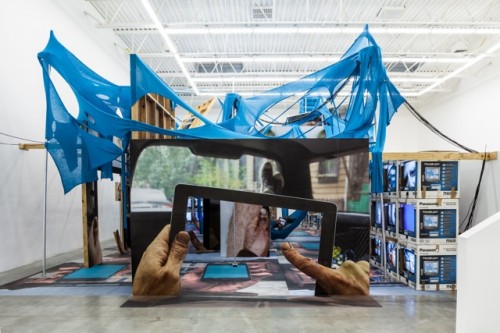
Jon Kessler. “The Web,” 2013 at Swiss Institute. Courtesy the artist and Métamatic Research Initiative, Amsterdam. Photo: Daniel Perez.
Jon Kessler has built a remarkable career out of rather clunky mechanized sculptures. A 1996 Guggenheim Fellow and a professor in Columbia University’s School of the Arts since 1994, Mr. Kessler has had solo exhibitions at the Museum of Contemporary Art, Chicago (1986), the Carnegie Museum of Art in Pittsburgh (1991), and P.S. 1 in New York (2005), to name but a few. Kessler’s art often balances dark themes and political subject matter with a wry humor and mesmerizing modes of presentation. In 2009, for example, he debuted Kessler’s Circus, a video sculpture that the Deitch Projects press release noted at the time “depicts the American military-industrial complex as macabre circus.”
In The Web, Mr. Kessler’s latest work currently on view at the Swiss Institute in New York City, the mediated scenes of modern warfare of Kessler’s Circus have been exchanged for the sublime spectacle of consumer culture. Kessler turns to contemporary visual culture, and specifically Apple Inc., to examine the impact of popular and commercial imagery and products on society’s desires and collective psyche.
The Web is a colorful, kinetic installation filled with whirling objects and brightly lit computer screens housed within a sprawling wooden construction. Kessler has mounted iPads, iPhones, and other Apple hardware throughout the installation, while surveillance cameras rotate back and forth on mechanized mounts. The quiet hum of the machinery is occasionally punctuated by the iconic sound of an Apple computer’s startup chime played over loudspeakers.
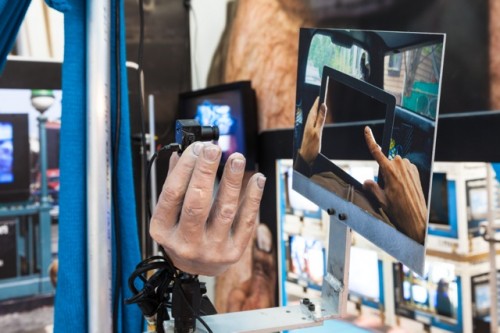
Jon Kessler. “The Web,” 2013 at Swiss Institute. Courtesy the artist and Métamatic Research Initiative, Amsterdam. Photo: Daniel Perez.
A variety of security cameras positioned throughout the installation—including tiny spy-cams held by lifelike disembodied hands—stream real-time footage across the network of monitors and screens situated throughout the installation, where they mix with prerecorded imagery of earlier visitors and footage culled from commercial advertising. Visitors can also download an iPhone app while in the exhibition space that will upload the images from their phone onto surrounding monitors. The brightly lit screens and banks of stacked television monitors create a kaleidoscope of video imagery, and visitors could certainly be forgiven if they at first mistake The Web for a fun, interactive tribute to Apple.
Before long, however, Kessler’s mechanized sculptural environment devolves into a technological hall of mirrors, as the montage of live and taped video produces a confusing loop of people observing themselves and others while they too are watched. As images of people no longer physically present in the exhibition space appear on the screens alongside those who still are, one struggles to keep track of what is and is not happening in real time. It can be a somewhat bewildering and even a bit disorienting experience as the installation presents and re-presents live and recorded video feeds, with little differentiation between the two (fittingly, one section of the sculptural installation is titled “Infinite Regress”). What is more, commercials for iPads and iPhones play on monitors wherein you see a live shot of yourself on the screens of the Apple products in the advertisement.
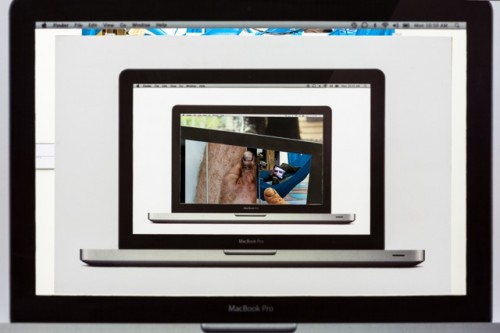
Jon Kessler. “The Web,” 2013 at Swiss Institute. Courtesy the artist and Métamatic Research Initiative, Amsterdam. Photo: Daniel Perez.
Adding to The Web’s hall-of-mirrors effect, visitors peer into different sections of the installation through cutouts of computer and iPad screens that Kessler has presumably culled from Apple advertisements and product packaging. In other words, objects of cultural consumption—commodities—often literally frame the visitor’s visual consumption.
Within The Web’s restless visual field visitors encounter on three different occasions a man lounging in a hammock. Dubbed the “Global Village Idiot,” this animatronic figure, whose features are based on Kessler’s own, relaxes as the security cameras spin to and fro and computer monitors flicker with endless streams of images around him. He has a long beard and is dressed in what might be called typical “hipster” attire: a brown zip-up hoodie with “BROOKLYN” written across the front, olive-drab cargo pants and a tattered pair of converse all-star sneakers without laces. One “Global Village Idiot” swipes through images from the surveillance cameras on his iPad while another FaceTimes on his MacBook with any visitors peering into an iPhone located in a far corner of the gallery. The third figure, tucked away in the back of the installation, holds his iPhone to his ear with one hand while masturbating with the other.
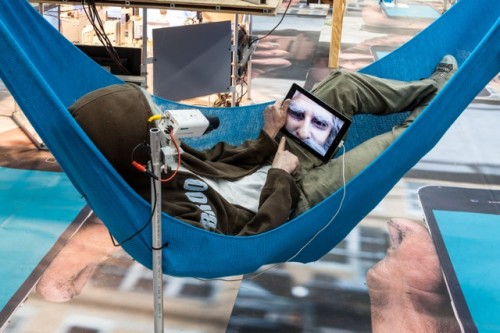
Jon Kessler. “The Web,” 2013 at Swiss Institute. Courtesy the artist and Métamatic Research Initiative, Amsterdam. Photo: Daniel Perez.
The “Global Village Idiot” has been a recurring figure in Kessler’s work for some years now. The moniker combines “village idiot” with Marshall McLuhan’s famous phrase, “Global Village,” which McLuhan coined in the early 1960s to describe the integrated, global audience resulting from the instantaneous worldwide reach of new electronic technologies. In conjoining “village idiot” and “global village,” Kessler apparently does not share McLuhan’s optimism about technology’s capacity to produce a globally unified community.
By mobilizing the conventional signs of what is popularly known as a “hipster”—a term generally used to identify a subcultural group that fetishizes seemingly authentic modes of being and living—Kessler’s “Global Village Idiot” figure suggests a more insidious relationship between technology, commercial advertising and self-expression than McLuhan envisioned. In fact, the “Global Village Idiot” and the experience of The Web as a whole seems closer to Theodor Adorno and Max Horkheimer’s ideas concerning the mass production of culture, which they called the “Culture Industry.”
In their book Dialectic of Enlightenment, published in 1947, Adorno and Horkheimer warn that seemingly authentic expressions of individual, even counter-cultural identity are increasingly filtered through a formulaic visual vocabulary of stylistic artifice carefully crafted by corporate marketing. Unlike McLuhan, Adorno and Horkheimer saw an increasingly homogenized culture as a threat to individuality and critical thought. They believed that the capitalist ethos of corporate and media culture manipulated and prescribed consumer desires in order to then satisfy them with their products. Adorno and Horkheimer proposed that those areas in life where people believed themselves to be genuinely free has in fact been compromised by the streamlined system of capitalism in which corporations supply a demand that they themselves helped to shape.

Jon Kessler, “The Web,” 2013 at Swiss Institute. Courtesy the artist and Métamatic Research Initiative, Amsterdam. Photo: Daniel Perez.
Kessler’s hipster figure of the “Global Village Idiot” might be considered the embodiment of the Culture Industry’s effects, where individual style is expressed and a seemingly authentic sense of self is validated through an increasingly homogenized menu of options. Kessler’s interest in the insidious relationship between mass production and mass consumption is suggested by the title of another of the artist’s works, Desert of the Real, from 2009. “Desert of the Real” is a phrase used by the philosopher Jean Baudrillard to describe the proliferation of images in late capitalism and, perhaps more famously, a phrase uttered by the character Morpheus in the Baudrillard-inspired The Matrix, a film in which reality is revealed to be nothing more than a simulation designed by machines to keep people enslaved.
Kessler’s use of iPhones, iPads and Macbooks in The Web seems particularly fitting to Adorno and Horkheimer’s ideas, as Apple is one of the largest companies in the world in terms of market capitalization thanks in part to its selling itself as the cool, independent “outsider” option to the big bad corporate behemoths. Indeed, Apple has consistently and successfully branded itself and its products as signifying some sort of authentic and individual form of expression, from the famous “1984” commercial in the early 1980s—in which Apple Macintosh is positioned as the counter-cultural rebel to IBM’s monolithic, even fascist corporate ethos—to their more recent ad campaigns in which a balding, suit-wearing corporate dolt represents the PC while the Mac is personified by a young, smart and composed guy in a t-shirt, jeans and sneakers.
With its surveillance cameras, “Global Village Idiot” and readymade commercial imagery of happy, beautiful people holding iPhones and iPads, The Web is not a celebration of technology in general and Apple in particular but a sober and sobering assessment of the technology and corporate aims behind our smartphone and social media culture. But perhaps The Web’s greatest feat is that its mesmerizing display of technology seduces as much as critiques. Rarely has a work of art attended so carefully to the beguiling seduction of visual culture, to which I willingly and enthusiastically succumbed by taking photos of The Web with my beloved iPhone 5. And as Adorno and Horkhemier (and Baudrillard) would probably tell you, that seduction is part of the allure of the Culture Industry.
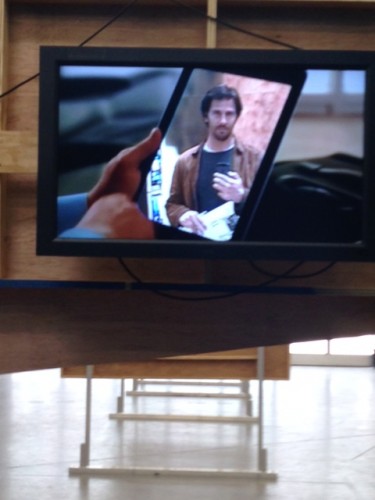
The author taking a picture of his own image as it appears on an iPad screen within a “commercial” running on a flatscreen monitor in Jon Kessler’s “The Web.” Photo: Max Weintraub.
Jon Kessler’s The Web is on view at the Swiss Institute in New York City through April 28, 2013.



